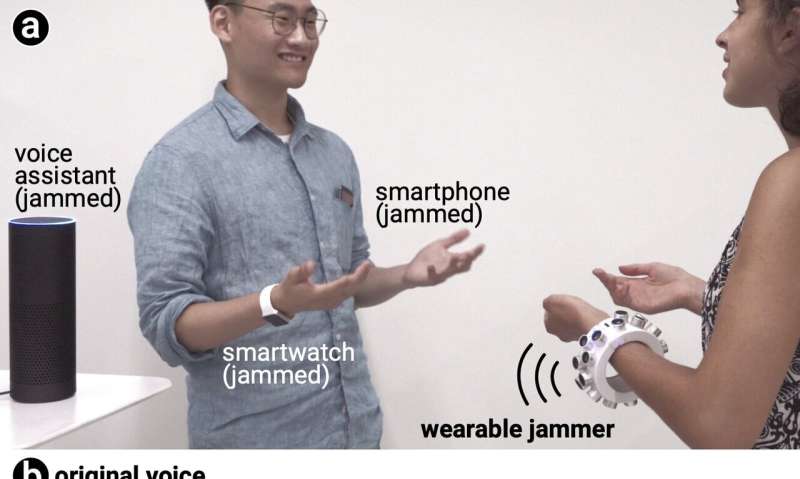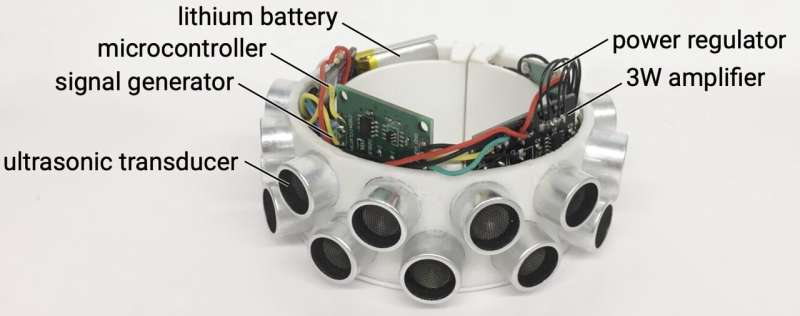February 19, 2020 weblog
Team develops bracelet that jams microphones

The very topic of digital assistants and home smart devices sporting microphones and the potential for the outside world to listen in on recordings is not a comfortable one, to say the least. It's no longer a simple case of who is listening, but what is listening in the connected world of devices in the home and beyond.
A University of Chicago team has come up with a wearable microphone jammer in the form of a bracelet that can disable microphones in a person's surroundings. The wearable jammer does its job against nearby and hidden microphones, thanks to researchers at the school's SAND Lab and the Human Computer Integration Lab.
The HCI lab researches interfaces that share part of the user's body, and explores new interface paradigms that could follow wearable devices. The SAND Lab (Systems, Algorithms, Networking and Data) at the university conducts research that spans such topics as security and modeling.
The bracelet emits ultrasonic noise to disable the microphones. According to the website Government Technology, the device randomly emits white noise within a range of 24 kHz to 26 kHz.
"We engineered a wearable microphone jammer that is capable of disabling microphones in its user's surroundings, including hidden microphones. Our device is based on a recent exploit that leverages the fact that when exposed to ultrasonic noise, commodity microphones will leak the noise into the audible range."
In a sample conversation in a February 14 video called "Wearable Microphone Jamming," posted on YouTube by the HCI lab, two people engage in conversation:
"So, tell me how it works."
"Sure. I can tell you how it works. But it's confidential."
The video shows instances of total silence during the times when the bracelet is activated, cutting out her description of how her secret project works. The transducers in the ring layout block out everything.
The bracelet jams microphones in speakers, smartwatches and smartphones. The wearable even works if microphones are covered by paper or cloth.

David Nield, writing on the website New Atlas, wrote further about how it works. The device is "crammed with 24 separate transducers that emit ultrasonic waves that interfere with microphones in all directions, even if they're hidden. By transmitting white noise randomly in the 24 to 26 kHz frequency range, mics in the immediate vicinity are only able to pick up static rather than spoken words."
The team prepared a paper for ACM CHI 2020, titled "Wearable Microphone Jamming." The authors are Yuxin Chen, Huiying Li, Shan-Yuan Teng, Steven Nagels, Pedro Lopes, Ben Zhao and Haitao Zheng.
"Despite the initial excitement around voice-based smart devices," the authors wrote, "consumers are becoming increasingly nervous with the fact that these interactive devices are, by default, always listening, recording, and possibly saving sensitive personal information. Therefore, it is critical to build tools that protect users against the potential compromise or misuse of microphones in the age of voice-based smart devices."
The bracelet is only a prototype for now, said Nield.
There is reason to believe that we might hear about this at a later stage. On the website Ubergizmo, Tyler Lee writes, "...its creators believe that they could manufacture it for as little as $20, and some of their investors have approached them with the idea to commercialize it."
In terms of commercialization, the bracelet is obviously not yet ready for the fashion runways; it has the lab prototype look of a bracelet in a kid's sci-fi movie, an aesthetic problem that could be addressed later.
According to their report, the jammer outperforms existing approaches with improved coverage and fewer blind spots. In the past, ultrasonic transducers have been "heavily directional, thus requiring users to point the jammer precisely at the location where the microphones are." This had its limits. The team realized that "this is not only impractical, as it interferes with the users' primary task, but is also often impossible when microphones are hidden."
Another limitation with these devices, they said, was that multiple transducers enlarge jamming coverage but introduce blind spots.
The authors conclude: "We confirmed that an ultrasonic microphone jammer is superior to state-of-the-art and commercial stationary jammers by conducting a series of technical evaluations and a user study. These demonstrated that: (1) our wearable jammer outperformed static jammers in jamming coverage; (2) its jamming is effective even if the microphones are hidden and covered by various materials, such as cloths or paper sheets; and, (3) in a life-like situation our study participants felt that our wearable protected the privacy of their voice."
More information: Yuxin Chen, Huiying Li, Shan-Yuan Teng, Steven Nagels, Zhijing Li, Pedro Lopes, Ben Y. Zhao, and Haitao Zheng. 2020. Wearable Microphone Jamming. In Proceedings of CHI Conference on Human Factors in Computing Systems 2020 (CHI'2020). doi.org/10.1145/3313831.3376304 (PDF)
© 2020 Science X Network





















